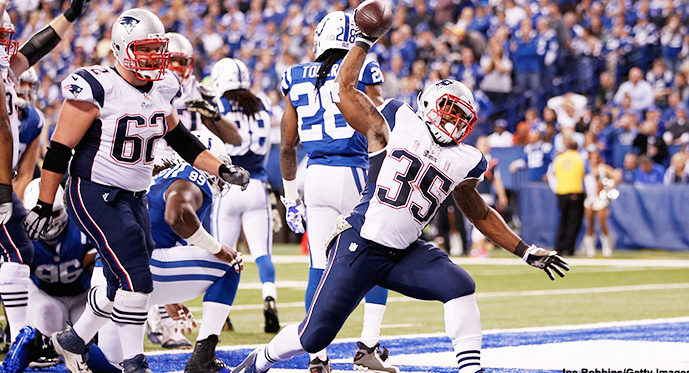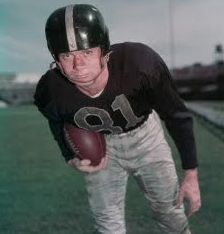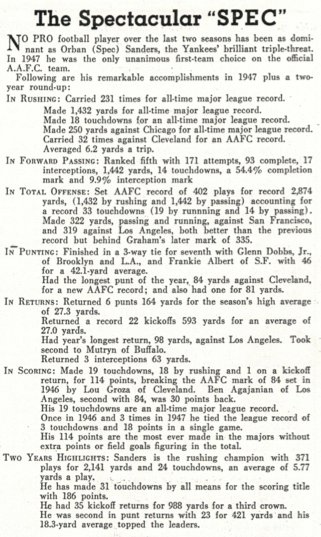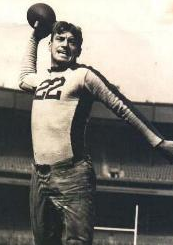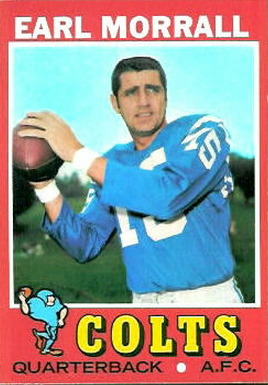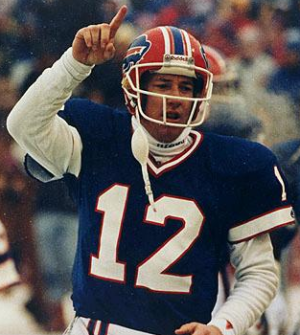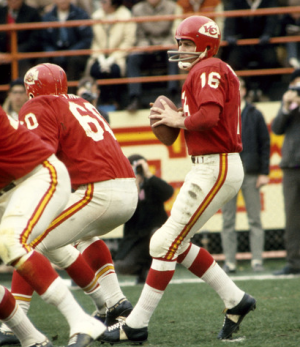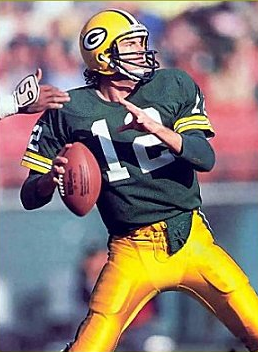Would it surprise you to learn that not one of Dan Marino’s 420 touchdown passes — he held the career record for a while, you may recall — was caught by a fellow Hall of Famer? (Guess I never thought about it, but yeah, I wouldn’t have imagined.) What’s more, Marino isn’t the only QB in Canton who can say that. Today’s entertainment:
Fewest TD Passes by a Hall of Fame QB to Another Hall of Famer (Modern Era)
0 Dan Marino, Dolphins, 1983-99 — Career total: 420.* Hall of Fame receivers: none.
0 Len Dawson, Steelers/Browns/Texans/Chiefs, 1957-75 — Career total: 239. Hall of Fame receivers: none.
3 Fran Tarkenton, Vikings/Giants, 1961-78 — Career total: 342.* Receiver: Hugh McElhenny, Vikings, 3.
6 George Blanda, Bears/Colts/Oilers/Raiders, 1949-58, ’60-75 — Career total: 236. Receiver: Fred Biletnikoff, Raiders, 6.
7 Sid Luckman, Bears, 1939-50 — Career total: 137. Receiver: George McAfee, 7.
9 Sammy Baugh, Redskins, 1937-52 — Career total: 187.* Receivers: Wayne Millner, 7; Cliff Battles, 1; Bill Dudley, 1.
Compare that to this list:
Most TD Passes by a Hall of Fame QB to Another Hall of Famer (Modern Era)
139 Johnny Unitas, Colts/Chargers, 1956-73 — Career total: 290.* Receivers: Raymond Berry, Colts, 63; Lenny Moore, Colts, 43; John Mackey, Colts, 32; Joe Perry, Colts, 1.
112 Sonny Jurgensen, Eagles/Redskins, 1957-75 — Career total: 255. Receivers: Charley Taylor, Redskins, 53; Tommy McDonald, Eagles, 30; Bobby Mitchell, Redskins, 29.
106 Jim Kelly, Bills, 1986-96 — Career total: 237. Receivers: Andre Reed, 65; Thurman Thomas, 22; James Lofton, 19.
98 Terry Bradshaw, Steelers, 1970-83 – Career total: 212. Receivers: Lynn Swann, 49; John Stallworth, 44; Franco Harris, 5.
85 Steve Young, Bucs/49ers, 1985-99 — Career total: 232. Receiver: Jerry Rice, 49ers, 85.
84 Norm Van Brocklin, Rams/Eagles, 1949-60 — Career total: 173. Receivers: Crazylegs Hirsch, Rams, 32; Tommy McDonald, Eagles, 29; Tom Fears, 22, Rams; Andy Robustelli, Rams, 1.
75 Dan Fouts, Chargers, 1973-87 — Career total: 254. Receivers: Kellen Winslow, 41; Charlie Joiner, 34.
65 Otto Graham, Browns, 1946-55 — Career total: 174 (All-America Conference included). Receivers: Dante Lavelli, 57; Marion Motley, 7; Lou Groza, 1.
*Former record holder.
Amazing, isn’t it? Van Brocklin (48.6 percent), Unitas (47.9), Bradshaw (46.2), Kelly (44.7) and Jurgensen (43.9) threw almost half their touchdown passes to Hall of Famers. Now those must have been good times.
The two receivers who grab your attention are Robustelli and Groza. After all, Andy was a defensive end and Lou an offensive tackle/kicker. What were they doing grabbing TD passes?
Naturally, I had to find out the stories behind the stories. What I learned:
Robustelli’s score came in the Rams’ 1954 finale against the Packers. (That’s when teams often pulled stunts like this, in meaningless end-of-the-season games.) The Associated Press described the play thusly:
A surprise pass by Norm Van Brocklin was the key play of the game. The Rams were ahead 21-20 in the third period when Van Brocklin was faced with a fourth down and 25 yards to go. He dropped back – supposedly to punt. Instead he dropped a short pass to defensive end Andy Robustelli, who presumably was in the game to run down under the punt. The 220-pound Robustelli rolled most of the 49 yards for the touchdown.
● A 49-yard touchdown pass to a defensive end on fourth and 25. It doesn’t get much better than that, folks. Green Bay never seriously challenged again. Final score: Rams 35, Packers 27. Here’s the headline that ran in The Milwaukee Journal the next day:

● As for Groza’s touchdown, it was semi-historic. How so, you ask? Well, first of all, he scored on a tackle-eligible play, which was still legal in 1950. Second, near as I can determine, it’s the last such play to go for a TD in the NFL (mostly because it took place, like Robustelli’s score, on the last Sunday of the season).
The next year this neat bit of chicanery was outlawed, and the rule book was amended to read: “A center, guard or tackle is not eligible to touch forward pass from scrimmage even when on end of line” (as was the case with Groza, who, being uncovered on the left side, became an eligible receiver).
Harold Sauerbrei’s recounting of Lou’s heroics in the Cleveland Plain Dealer:
“With the ball on the 23, Groza broke away from his [line] post and Graham laid a soft pass between two defenders into Groza’s arms, Lou running 13 yards for the score.”
The fourth-quarter touchdown increased the Browns’ lead over the Redskins to 17, and they went on to a 45-21 victory. Two weeks later, they won their first NFL title.
If you’re wondering how some current quarterbacks might fit into this, Peyton Manning threw 112 TD passes when he was with the Colts to Marvin Harrison and four to Marshall Faulk. Assuming Harrison makes it to Canton, that’s 116 right there, which would put Manning second behind Unitas. But he could add to that number and possibly pass Johnny U. if any of his Broncos receivers — Wes Welker (11), Demaryius Thomas (30) or Julius Thomas (22) — gets voted in. (The same goes for Edgerrin James, who caught 11 scoring passes from him in Indianapolis.)
The Patriots’ Tom Brady also could overtake Unitas. At the moment, his ledger reads: 39 touchdown passes to Randy Moss, 34 to Welker and 49 (and counting) to Rob Gronkowski. Total: 122 (again, if all three wind up in the Hall, which is hardly guaranteed). But the way Gronk is going, Brady could push that figure quite a bit higher.
Source: pro-football-reference.com
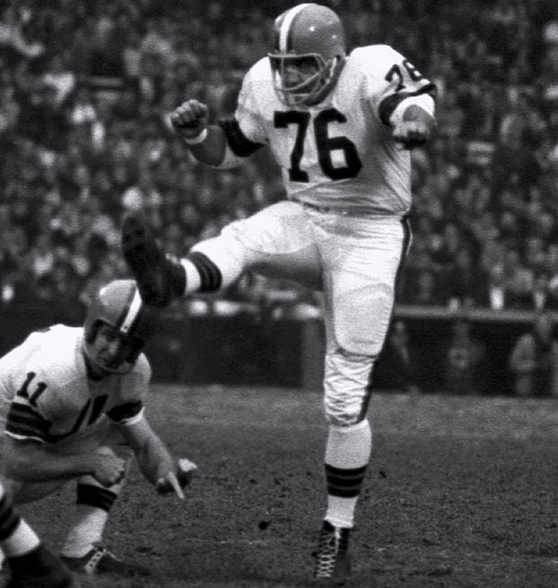
Hall of Famer Lou Groza, remembered mostly for his kicking, once caught a TD pass from Otto Graham.

